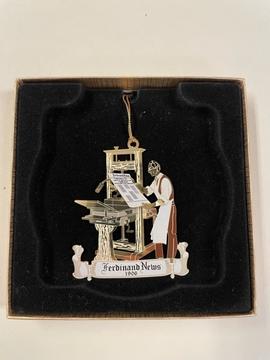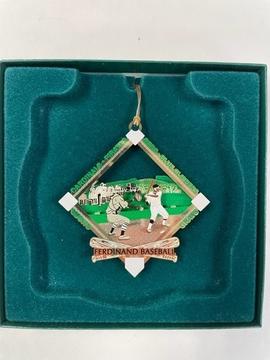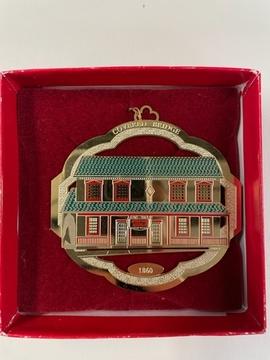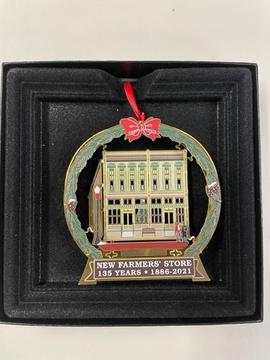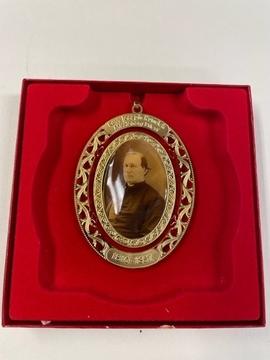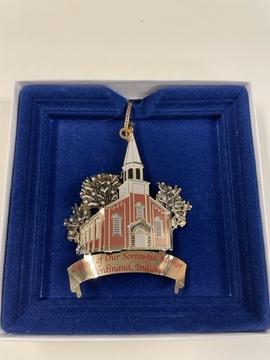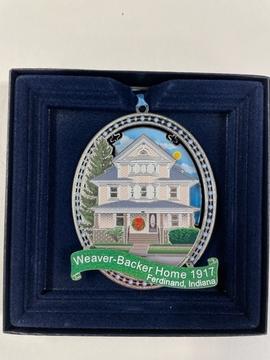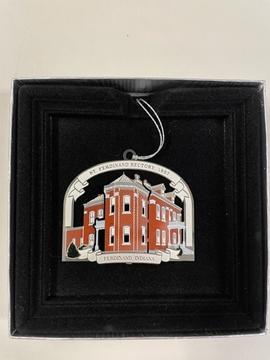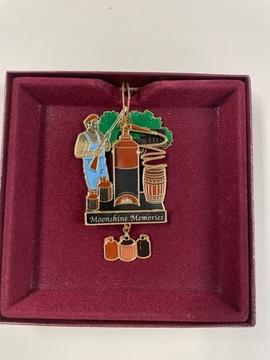newspaper articles, book entries, computer copied photos, note card
Backert, ClaudiaFerdinand, Indiana
35 Archival description results for Ferdinand, Indiana
First issue of the community newspaper, published May 25, 1906. The Commerce Club sold the newspaper to Henry Haake who named it the Ferdinand News. In 1944 his daughter Agnes took over until his son Oscar and J. Roy Haake returned from military service. The brothers operated the paper until their retirement in 1990. They sold it to Richard Tretter, and is currently operated by Kathy Tretter.
This ornament commemorates all of the Early Ferdinand baseball teams. Early teams were the Black Sox (1890), the Ferdinand Blue Clippers (circa 1900), the Scrubs (1903), the Ferdinand Reds (1904-08) the Ferdinand Grays (1913-15), Ferdinand Giants (1920-22 and 1924-28), and the Ferdinand Cardianls (1930-1982 reorganized in 1988 but defunct 1993).
The Weyer (later Mullis) Tourist Home was a Ferdinand tradition from 1925 to the late 1970's. Operated by Anna Weyer in earlier years, the home served breakfast,lunch and supper to guests, as well as hosting weddings, banquets and First Communion celebrations. Taken over by Bill and Emma Mullis (Mrs. Weyer's daughter and son in law) in 1947,it stayed in operation until 1978. Indiana Landmarks state the home on 7th and Main was built in 1875.
The Covered Bridge was constructed in 1860 by John B. Gohman who named it the Indiana Hotel. It was a stagecoach inn with four large sleeping rooms and a dining room. Since then, it has housed The Ferdinand News, a bakery, barber shop, photography studio, and cobbler shop. In 1931, it was purchased by Clarence Quante. It was renovated and made into a tavern and dancing hall. It has changed hands several times since but has again been renovated and reopened as an upscale restaurant in 2001.
St. Ferdinand Catholic Church was begun in 1846 by the founder of Ferdinand, Fr. Joseph Kundek, and completed in 1848. The church was doubled in size and the tower added in 1866. The church is located on the High Chapel Reserve and serves as the center of the German community of Ferdinand. It is constructed mostly of locally quarried sandstone.
Silent night, holy night, all is calm, all is bright. These words could easily describe this ornament. Rev. Joseph Kundek took a leap of faith in 1840 when he founded Ferdinand, nestled in the rolling hills of Southern Indiana. Rev. Kundek wanted to create his own model community and considered Germans to be a most industrious bunch, so he advertised land for sale in German-language newspapers as far away as Cincinnati, Ohio and Pittsburg, Pa. He promoted a "thriving" community, but all the weary immigrants found when they arrived was a sign nailed to a tree with "Ferdinand" painted on it. The faint of heart got back on the trail and headed west for Evansville or points beyond. But others stayed and made this new community, named after Emperor Ferdinand I of Austria, their final destination. Almost 175 years after its founding, Ferdinand truly is the thriving community Rev. Kundek envisioned. Rev. Kundek's faith is still apparent, with Monastery Immaculate Conception perched on a hill, the awe-inspiring St. Ferdinand Church in the heart of town, and a Baptist Church family on the north side of Ferdinand.
Monastery Immaculate Conception, home of the Sisters of St. Benedict, was founded by four Benedictine sisters from Covington, KY. on August 20, 1867, to begin teaching German immigrants. Construction of the present church, one of the architectural wonders of southern Indiana was begun in 1915 and, after delays because of World War I, was completed in 1924. The sisters began a major restoration of their church in 2001. The Ferdinand Benedictine community is one of the largest Benedictine communities of women in the United States. This ornament was issued during the sisters' 2002 Summer Social, which commemorates the 135th anniversary of the Sisters of St. Benedict in Ferdinand.
Ferdinand, Indiana, was just a dream in 1838, when Rev. Joseph Kundek, a Croation missionary priest, decided he would create a model German Catholic community in the heart of the southern Indiana wilderness.He was already serving the residents of Jasper and wanted a stopping off point between that growing city and Troy on the Ohio River. Many settlers journeyed to the the area via riverboat and raft, completing the journey north on foot. Fr. Kundek purchased a significant tract of land which John Cassidy had surveyed on January 8, 1840. This years ornament is a representation of the original plat, drawn by Fr. Kundek himself.
1906 was a very good year for the Town of Ferdinand. A Commerce Club was formed by community members who took it upon themselves to found a newspaper and to begine selling stock in the Ferdinand Railroad Company. The Ferdy Flyer made its first official trip in 1908. Reputedly the shortest independently-owned railroad in the nation during its 85 years of operation, the Ferdy Flyer chugged daily over 6.48 miles of track to Huntingburg and back again. Engine #3, a 50-ton locomotive built in 1913, pulled an 1880 manufactured coach transporting male students to and from Huntingburg High school before a secondary school was built in Ferdinand in 1951. The train also brought thousands of guests for the annual St. Ferdinand Church picnic. The Ferdy Flyer also carried products as diverse as communion wine, locally made furniture, raw building materials, mail and tobacco. Alas, what the Ferdy Flyer never did was make money. With the advent of truck transportation and an automobile for every household., the railroad went into decline. Today it is just a memory.
Ferdinand Township was called "The Wooden Shoe Township" because many residents wore wooden shoes during the 19th century and, even in the early years of the 20th. The basis for this years ornament is a 1911 photo of Clemens Luken, who hand crafted wooden shoes until his death in 1917. Clemens, his wife and daughter, came directly from the German state of Hanover in 1869 to Ferdinand. In 1911 the Evansville Courier reported that Clemens sold his shoes for 45 to 65 cents a pair. They were shipped by the barrel to Cook's Brewery in Evansville for workers to wear in the damp brewery. Many shoes were also sold as souvenirs. Mr. Lukens was only one of a very long list of shoemakers who have done business in Ferdinand.
Henry Bromm built this structure at 11th and Main Street in 1901. He then sold it to Valentine Fleig Mr. Fleig was a local baker, born in Baden, Germany in 1870. In 1906, Mr Fleig leased the building to Ben Knust, but returned to his original business in 1910. On Dec. 10, 1910, Fleig's Saloon hosted a huge grand opening. Mr. Fleig operated the business until 1938, selling it to his son Edward. Edward continued the business in the original building until 1969. The building was demolished to make room for today's Old National Bank. Fleig's Cafe is still in operation in the corner building on 9th and Main.
This three story classical Romanesque-revival school was built between 1906 and 1908 by the Seufert Construction Co. Donated labor kept the cost low. The building was constructed of red brick from a local brickyard. The facade was graced with 19 arched windows, each ten feet high. It was trimmed with hand-hewn sandstone, unique limestone trim, and a slate roof. Solid oak adorned the interior and double staircase. The second floor theatre featured a 16.5 foot embossed tin ceiling. The building was used as a school facility on the Ferdinand Elementary campus until 1989. The former school was used as St. Ferdinand Catholic Church's Spiritual Life center until 1998. It was demolished in 1998.
The Fire Department was incorporated in 1905. The first Fire Chief was also the Town Marshall.For the first few years, three separate hose carts were kept in separate locations in three town wards. Today's firefighters treasure the memorabilia of yesteryear and still possess the 1875 fire truck, 1907 hose cart, and 1914 chemical wagon. This ornament celebrates the Fire Departments first 100 years.
Florenz Kitten, Sr. (1840-1920) emigrated from Germany to Ferdinand at the age of 10. He founded a thriving manufacturing business, the Kitten Machine Shop (later the Kitten Foundry & Machine Works). He obtained several patents for his own inventions and improved on other inventors designs. From 1880 through 1940, a total of 224 steam engines were built. There are still roughly 20 in existence. Kitten Steam Engines and related equipment were noted for their exceptional quality. In its heyday, the foundry was Ferdinand's largest industry.
Built in 1886 on the corner of 13th and Main for John Henry Beckmann, the New Farmer's' Store was an iconic structure fronted by a stunning Italianate facade. One of Ferdinand's oldest surviving buildings, the structure has served many purposes the last 135 years. Many still recall Bartley's General Store and Mill, Verkamp's Red and White Grocery Store and many others. The building sat empty for roughly 10 years until 2019 when it was purchased by Keith Fritz from the estate of the late Joe Mehling. The building is being restored to its former glory and redone as an art gallery, Airbnb suite, and hopefully fine restaraunt.
This ornament commemorates the Archangel Gabriel, the guardian of the Monastery church. This is one of the nine angels in the curved outer wall of the Monastery Church Sanctuary. The stained glass windows are original to the Church which was completed in 1924. The Sisters of St. Benedict estimate there are roughly 90 angels throughout the church, embodying St. Benedict's belief that angels are always watching over us. The window colors are rich and bold jewel tones.
Ferdinand celebrates its 25th annual Christkindlmarkt -- a tradition that began in the 14th century Germany. For 2022 the Ferdinand Historical Society ornament features a joyful Weihnachtsmann / Father Christmas bearing gifts to commemorate this special occasion.
Ferdinand Historical SocietyFerdinand celebrates its 25th annual Christkdlmarkt-- a tradition that began in 14th century Germany. For 2023 the Ferdinand Historical Society ornament features the Peter Muller Home. It was built in 1867 at 314 West 9th Street by Peter Muller. Mr. Muller came to Ferdinand around 1840 and became a prosperous mill operator. Mr. Muller was also the first Ferdinand resident to own an automobile (1909). The house is still in use today as a vibrant and fun cultural center, "Traditional Arts Today".
Ferdinand Historical SocietyFr. Kundek was born in Ivanic, Croatia August 24, 1810. He was ordained August 17, 1835 for his home Diocese of Agram. Several years later he was transferred to the United States as a missionary priest. He was the lone priest in central Southern Indiana except for Perry County. He founded St. Joseph's Catholic Church in Jasper and the towns of St. Anthony, Celestine, Fulda, Mariah Hill, and Ferdinand. He chose the name Ferdinand in honor of the emperor of Austria, who donated generously to Fr. Kundek. Fr. Kundek died December 4, 1857 and is buried in St. Joseph's Catholic Church Cemetery in Jasper. In his 47 years he accomplished more than most men could ever dream of.
An iconic structure, The Chapel of Our Sorrowful Mother, graces the hill South of the Monastery. Bishop Martin De Saint Palais gave permission to erect the chapel in 1875. The Romanesque brick structure cost $6,464.64 to build. It was solemnly dedicated on March 23, 1877 on the Feast of the Seven Sorrows of the Blessed Virgin Mary.
The Weaver Backer Home has been a fixture on Ferdinand's Main Street for over 100 years. The house was built in 1917 by Albert Weaver. It is an excellent example of the Free Classic style prevalent in the early 20th century. This beautiful landmark, known as the "Backer Home" still stands in the community.
The St. Ferdinand Parish Rectory was constructed in 1897 for $10,833.50. It was built for the beloved Father Eberhard Stadler, the 5th pastor of St Ferdinand Catholic Church. He was pastor for 27 years. He oversaw or was responsible for many improvement in the parish as well as the Town of Ferdinand during that time. He died on June 28, 1898 and is buried in the St Ferdinand Cemetery.
Ferdinand recognizes its legendary moonshiners of the Prohibition years and beyond. Dubois County moonshine was prized for its flavor and purity. Even Al Capone was known to visit Ferdinand to purchase the product. Moonshine helped local folks survive the Great depression. Ironically, moonshine provided the foundation for many local industries as the moonshiners invested their profits in start up companies instead of bank accounts.
The Wollenmann House, located at 1150 Main Street is one of the most recognizable landmarks in Dubois County. The home, with its distinctive Swiss chalet like architecture, was commissioned in 1903 by Dr. Alois Wollenmann. Dr. Wollenmann was from Switzerland. Dr. Wollenmann was a doctor, ran the local drug store, was postmaster and also had a watch shop. Dr. Wollenmann was a Civil Rights activist long before any locals had ever heard the term. Bucking early 20th century norms, he treated Native Americans and employed African Americans. The Wollenmann Home has been preserved intact by successive generations of Wollenmann's and is broadly known.
4 - Madonna Hall Library Renovations Detail
Eugene Hausmann WHGK Architects70- Complete set of blueprints detailing site preparation, exterior and interior details, electrical, plumping and mechanical, door scheduling, floor plans- basement, floors 1-5, penthouse.
Hellmuth,Obata, and Kassabaum, Inc. (Architects) William Tao and Associates (Mechanical Engineer) Albert Alper (Structural Engineer) Flambert and Flambert (Food Service Consultant)29- continuation of complete set of blueprints detailing, site preparation, exterior and interior details, electrical,plumbing and mechanical, door scheduling, floor plans-basement, floors 1-5, penthouse.
Hellmuth, Obata and Kassabaum, Inc., Architects1 Ariel view and 1 surveyor's drawing of property lines.
Mehling Engineering & Surveying, Inc.6 - Blueprints electrical details.
Montgomery Engineering CorporationThe Monastery Immaculate Conception is located in Ferdinand. The history of the two is closely related. This file contains news clippings relating to the town of Ferdinand.
Ferdinand, IndianaThe town of Ferdinand, Indiana, celebrated its 150th founding anniversary (sesqui-centennial) in 1990. The Sisters participated in the events of the celebration.
Ferdinand Sesqui-centennial Celebration, July 1 - 7, 19901 - Stair Plan View, Sections, and Detail
Wayne E. Seufert & Associates, Inc - JonThese are yearbooks from St. Ferdinand High School which is now Forest Park High School. Ferdinand Benedictines have served on the staff throughout the school's history with the exception of a few years in the late 1990's.
St. Ferdinand High School, Ferdinand, Indiana